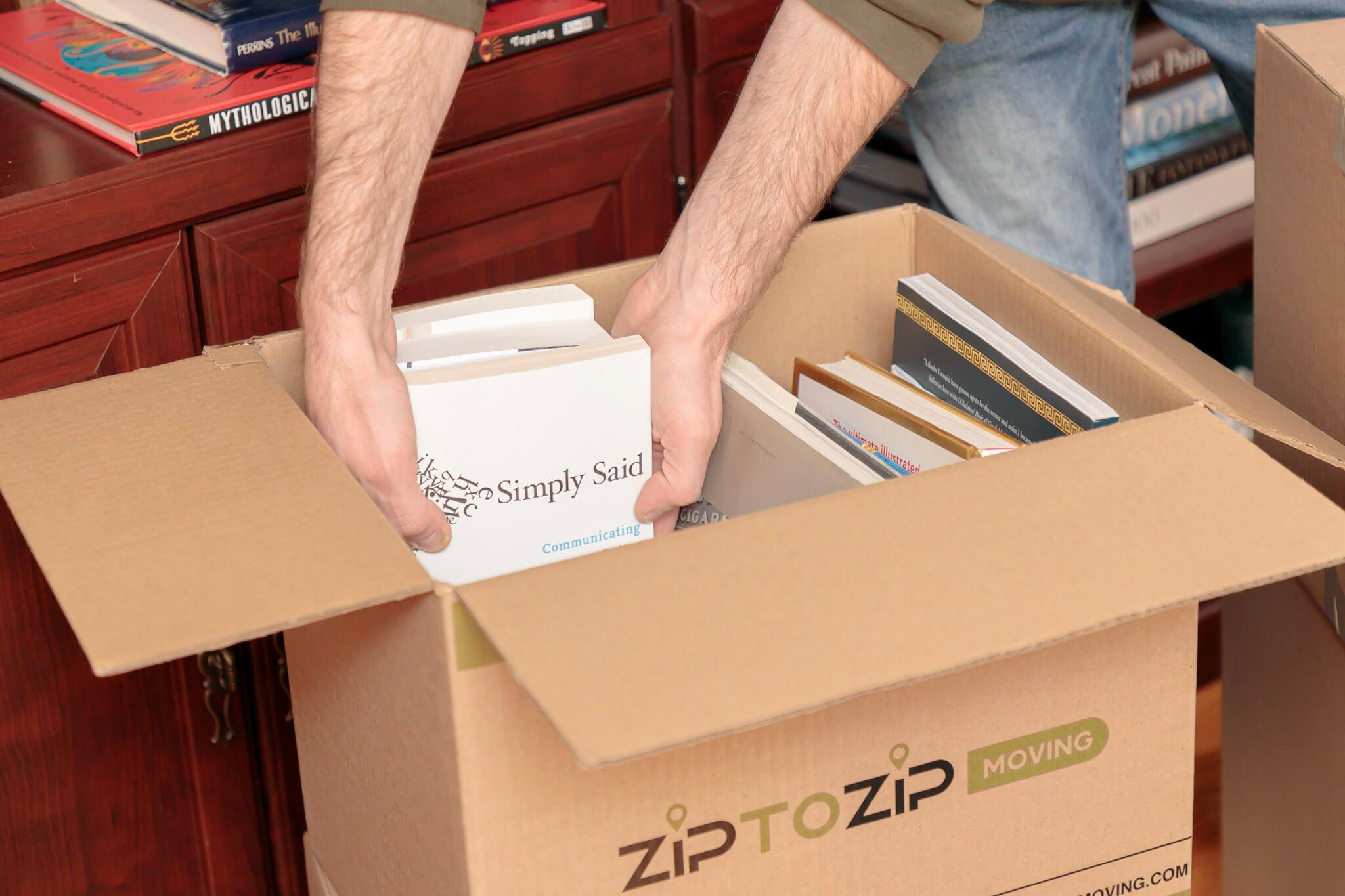What is the Best Way to Transport Books Safely?
Moving can be a daunting task, especially when it comes to your cherished book collection. You’ve spent years curating your library, and the thought of damaging your favorite novels, rare editions, or academic textbooks during a move might be keeping you up at night.
But fear not! There are tried and tested methods to ensure your books make it to your new home safely and soundly. Imagine unpacking your books in perfect condition, ready to line your new shelves without a scratch or bent corner in sight.
You will discover the best ways to transport your books when moving, ensuring their safety and your peace of mind. Stick around to uncover the secrets that could save you from unnecessary stress and potential book mishaps.
Choosing The Right Packaging
Moving can be stressful, especially for book lovers. Books are precious. Proper packaging is essential to protect them during the move. Choosing the right packaging ensures your books arrive safely. This section focuses on selecting sturdy boxes and using protective materials.
Selecting Sturdy Boxes
Strong boxes are vital for transporting books. Look for cardboard boxes. They should be thick and durable. Corrugated boxes offer extra strength. They hold heavy books well. Choose boxes that fit your books snugly. Avoid oversized boxes. Books may shift and cause damage.
Using Bubble Wrap And Packing Paper
Bubble wrap shields books from harm. Wrap each book individually. This prevents scratches and dents. Packing paper fills empty spaces. It provides cushioning. Place paper between books. This stops them from moving around. Secure wrapped books with tape. This keeps them safe and intact.
Organizing Books For Packing
Choosing sturdy boxes ensures safe transport for books during a move. Placing heavier books at the bottom maintains balance. Wrapping each book in paper prevents damage and keeps them clean.
When moving to a new home, your beloved book collection might be one of the heaviest, yet most cherished items to pack. Organizing books for packing requires a thoughtful approach to ensure they arrive safely and in good condition. You don’t want to open a box in your new living room only to find pages crumpled or covers bent. Let’s delve into some effective strategies to make this process seamless.Sorting By Size And Weight
Begin by sorting your books according to their size and weight. It’s a practical way to ensure that your boxes are evenly balanced, which makes them easier to carry. Larger, heavier books should be packed at the bottom of the boxes to provide a stable base. Consider this: when you stack a few hefty hardcovers at the bottom, it also prevents lighter paperbacks from being crushed. Avoid overloading the boxes, though. Your future self will thank you when lifting them into your new home!Arranging By Fragility
Books with delicate spines, rare editions, or those with sentimental value require special attention. Arrange these fragile items separately and consider wrapping them individually in bubble wrap or packing paper. This extra layer of protection can make a significant difference. Have you ever opened a box only to find a favorite book with a torn dust jacket? This simple step can prevent such heartaches. Place these fragile books on top of sturdier ones within the box, ensuring they aren’t under pressure. Taking the time to organize your books for packing can save you plenty of stress during the unpacking process. How do you decide which books deserve extra care? What’s your strategy for keeping them safe? Share your thoughts below!Packing Techniques
Moving books can be a daunting task. They are heavy, bulky, and easily damaged. Proper packing techniques ensure safe transport. This guide will focus on two effective strategies. They provide stability and prevent movement during transit.
Layering For Stability
Start by selecting sturdy boxes. Smaller boxes work best for books due to their weight. Line the bottom with packing paper for cushioning. Place books flat in the box to prevent spine damage. Alternate the direction of the books in each layer. This method creates a stable base. It also distributes weight evenly.
Avoid overpacking the box. Leave some space at the top. This prevents the box from becoming too heavy to lift. Securely close the box with packing tape. Label each box with its contents. This helps with organization later on.
Filling Gaps To Prevent Movement
Gaps between books can cause shifting. Fill these spaces with soft materials. Use crumpled paper, bubble wrap, or even small towels. This padding absorbs shock during transport. It also keeps books in place.
Check the box by gently shaking it. If books move, add more filler. A snug fit is key to preventing damage. Once packed, seal the box securely. Ensure labels are visible for easy identification. These steps safeguard your collection on moving day.
Protecting Book Covers
Books hold stories and knowledge worth preserving. Their covers deserve protection during moves. Damaged covers diminish the book’s charm and value. Keep them pristine with proper techniques.
Using Protective Sleeves
Protective sleeves shield book covers from scratches and dust. Choose sleeves made of plastic or fabric. They fit snugly around each book, offering a barrier. This method prevents wear and tear during transportation.
Securing With Tape
Tape secures book covers and keeps them intact. Use painter’s tape to avoid leaving residue. Place it carefully along the edges. This technique holds covers in place and prevents bending. Ensure the tape is snug but not too tight. This maintains the book’s original shape.
Labeling And Handling
Moving can be a daunting task, especially when it involves transporting your cherished book collection. Proper labeling and handling are critical to ensuring your books arrive safely at your new home. You might think, “How hard can it be?” But without the right strategies, you could end up with damaged books and an unnecessary headache.
Marking Boxes Clearly
Imagine unpacking at your new place and realizing you can’t find your favorite book because the boxes are not labeled. A clear labeling system is your best friend here. Use bold markers to write on the top and sides of each box. Include the genre or specific titles if necessary. This way, you won’t have to dig through every box to find your beloved mystery novels.
Consider color coding your labels if you have a large collection. Assign different colors to different genres or authors. It adds a layer of organization and makes locating your books a breeze.
Proper Lifting Techniques
Ever tried lifting a box of books and felt like you were lifting a mini library? Books are heavy! It’s crucial to use proper lifting techniques to avoid injury. Bend your knees and keep your back straight. Lift with your legs, not your back. This simple adjustment makes a world of difference.
Don’t overload your boxes. It’s tempting to fill them to the brim, but it’s safer to keep the weight manageable. Consider using smaller boxes specifically for books. They’re easier to handle and reduce the risk of damage to both you and your books.
Have you ever moved your books and discovered the boxes were falling apart? Quality boxes are worth the investment. They provide better support and protection for your treasured collection.
When handling your book boxes, think about the journey they will take. Will they be stacked? Moved multiple times? Make sure they are well-sealed and reinforced, especially if they’re going on a long trip.
Have you considered using a dolly or cart for transport? It’s a simple tool but makes moving heavier boxes much more manageable. Why strain your back when you can roll your way to the moving truck?
What strategies have you found helpful in transporting your books safely? Share your thoughts in the comments below and let’s build a community of book lovers who move smarter!

Credit: moveadvisor.com
Choosing Transportation Mode
Transporting books during a move can be challenging. Books are heavy and can get damaged. Choosing the right transportation mode is crucial. This decision affects the safety and condition of your books. Two main options are available: using a personal vehicle or hiring professional movers.
Personal Vehicle Tips
Using your car gives you control over handling. Pack books in sturdy boxes. Ensure boxes are not too heavy. Balance the weight for easy lifting. Place boxes flat to avoid bending. Use blankets to prevent sliding. Secure boxes with straps if needed. This method is cost-effective. It allows careful handling of your valuable books.
Professional Moving Services
Professional movers offer convenience. They handle heavy lifting for you. Movers have experience with fragile items. They use specialized packing materials. This reduces the risk of damage. Choose a reputable moving company. Check reviews and ask for references. Discuss your specific needs with them. Ensure they understand the importance of your books. This option may cost more. It ensures your books arrive safely.
Climate Considerations
Transporting books during a move requires careful planning. Choose sturdy boxes and pack books spine down. This method protects them from damage. Consider the climate of your new location to prevent moisture damage. Properly packing and considering climate ensures your books arrive in great condition.
Moving is a daunting task, and when it comes to transporting books, climate considerations are crucial. Books are sensitive to environmental changes, and improper handling can lead to damage. Whether you’re moving across the country or just down the street, understanding how climate affects your books will help keep your beloved collection safe.Avoiding Extreme Temperatures
Books are vulnerable to extreme temperatures. Heat can cause pages to warp and bindings to crack, while cold can make them brittle. If you’re moving during summer or winter, think about how to shield your books from these conditions. Consider transporting them in your climate-controlled car rather than a moving truck. When I moved last summer, I placed my most treasured books in the backseat, where I could control the temperature. This way, they stayed cool and undamaged, even during a heatwave.Protecting From Moisture
Moisture is a silent but destructive enemy of books. It can lead to mold, mildew, and even irreversible water damage. How do you ensure your books remain dry during a move? Use plastic bins instead of cardboard boxes for added protection. During a rainy move, I learned that a few garbage bags around a cardboard box won’t cut it. Investing in sturdy plastic bins saved my collection from an unexpected downpour. Have you ever considered using silica gel packs? They absorb moisture and are a simple way to add an extra layer of protection. Slip a pack or two into each box or bin to keep humidity at bay. How do you plan to safeguard your books from the elements when you move? By thinking ahead and taking these practical steps, you can ensure your treasured collection arrives in perfect condition.
Credit: www.reddit.com
Unpacking Safely
Unpacking safely ensures your books remain in perfect condition after a move. Proper handling prevents damage and keeps your collection organized. Let’s explore the best practices for unpacking your books safely. Follow these steps for a smooth transition to your new home.
Inspecting For Damage
Check each book as you unpack. Look for bent corners or torn pages. Inspect the covers for scratches or stains. Damaged boxes often lead to damaged books. Be careful with fragile covers and bindings. Handle old books with extra care. Take time to assess each item.
Organizing On Arrival
Sort books by genre or author as you unpack. Place them on shelves immediately. Use a system that fits your style. Keep series together for easy access. Store reference books in a handy spot. Ensure rare books are stored safely. Organizing helps maintain their condition.

Credit: www.youtube.com
Frequently Asked Questions
How To Pack Books For Moving?
To pack books, use small boxes to avoid heavy lifting. Stack books flat to prevent damage. Fill gaps with packing paper to keep them secure. Label each box clearly to ensure easy unpacking. Consider using plastic bins for added protection against moisture during transport.
Are Plastic Bins Better For Book Transport?
Yes, plastic bins offer excellent protection against moisture and dust. They are sturdy and stackable, providing safe transport. Ensure bins are not overloaded to avoid damage. Use bubble wrap or packing paper for extra cushioning. Always seal bins tightly to prevent any exposure to elements.
Should I Use Bubble Wrap For Books?
Bubble wrap is useful for protecting valuable or fragile books. Wrap each book individually to prevent scratches and dents. Secure with tape and place in boxes carefully. For most books, packing paper is sufficient. Always check for moisture-resistant options when packing.
Can I Use Suitcases For Transporting Books?
Suitcases can be convenient for transporting small quantities of books. Ensure weight distribution is even to prevent damage. Use packing paper or cloth for cushioning. Avoid overloading to preserve suitcase integrity. Wheels on suitcases make transport easier, reducing strain during the move.
Conclusion
Transporting books safely is essential during a move. Choose sturdy boxes. Wrap fragile covers in paper for protection. Label boxes clearly to avoid confusion. Keep weight manageable to prevent injury. Stack boxes neatly to save space. Consider using suitcases with wheels for heavier loads.
Prioritize valuable or rare books for extra care. Staying organized will make unpacking smoother. Remember, preparation reduces stress. Your books can arrive safely in your new home. Enjoy settling into your new space with your favorite reads nearby. Happy moving!





